2012 年 6 月英语六级真题及答案
Part Ⅰ Writing (30 minutes)
Directions:For this part, you are allowed 30 minutes to write a composition
on the topic The Impact of the Internet on Interpersonal Communication. You should
write at least 150 words but no more than 200 words.
The Impact of the Internet on Interpersonal Communication
Part Ⅱ Reading Comprehension (Skimming and Scanning)(15minutes)
Directions: In this part. You will have 15 minutes to go over the passage quickly
and answer the questions on Answer Sheet 1. For questions 1-7, choose the best answer
from the four choices marked A)、B)、C)and D). For questions 8-10, complete the
sentences with the information given in the passage.
The Three-Year Solution
Hartwick College, a small liberal-arts school in upstate New York, makes New
York, makes this offer to well prepared students: earn your undergraduate degree
in three years instead of four, and save about 543,000—the amount of one year’s
tuition and fees. A number of innovative colleges are making the same offer to
students anxious about saving time and money. That’s both an opportunity and a
warning for the best higher-education system in the world.
The United States has almost all of the world’s best universities. A recent
Chinese survey ranks 35 American universities among the top 50, eight among the top
10. Our research universities have been the key to developing the competitive
advantages that help Americans produce 25% of all the world’s wealth. In 2007,
623,805 of the world’s brightest students were attracted to American universities.
Yet, there are signs of peril (危险)within American higher education. U.S.
colleges have to compete in the marketplace. Students may choose among 6,000 public,
�
private, nonprofit, for profit, or religious institutions of higher learning. In
addition, almost all of the 532 billion the federal government provides for
university research is awarded competitively.
academic
departments,
But many colleges and universities are stuck in the past. For instance, the idea
of the fall-to-spring“school year”hasn’t changed much since before the American
Revolution, when we were a summer stretch no longer makes sense. Former George
Washington University president Stephen Trachtenberg estimates that a typical
college uses its facilities for academic purposes a little more than half the
calendar year.“While college facilities sit idle, they continue to generate
maintenance expenses that contribute to the high cost of running a college,” he
has written.
Within
with
age-discrimination laws, makes faculty turnover—critical for a university to
remain current in changing times—difficult. Instead of protecting speech and
encouraging diversity and innovative thinking, the tenure system often stifles(压
制)them: younger professors must win the approval of established colleagues for
tenure, encouraging like-mindedness and sometimes inhibiting the free flow of ideas.
Meanwhile, tuition has soared, leaving graduating students with unprecedented
loan debt. Strong campus presidents to manage these problems are becoming harder
to find, and to keep. In fact, students now stay on campus almost as long as their
presidents. The average amount of time students now take to complete an undergraduate
degree has stretched to six years and seven months as students interrupted by work,
inconvenienced by unavailable classes, or lured by one more football season find
it hard to graduate.
tenure( 终 身 职 位 ) , combined
Congress has tried to help students with college costs through Pell Grants and
other forms of tuition support. But some of their fixes have made the problem worse.
The stack of congressional regulations governing federal student grants and loans
now stands twice as tall as I do. Filling out these forms consumes 7% of every tuition
dollar.
For all of these reasons, some colleges like Hartwick are rethinking the old
way of doing things and questioning decades-old assumptions about what a college
degree means. For instance, why does it have to take four years to earn a diploma?
This fall, 16 first-year students and four second-year students at Hartwick enrolled
in the school’s new three year degree program. According to the college, the plan
is designed for high-ability, highly motivated student who wish to save money or
to move along more rapidly toward advanced degrees.
By eliminating that extra year, there year degree students save 25% in costs.
Instead of taking 30 credits a year, these students take 40. During January, Hartwick
runs a four week course during which students may earn three to four credits on or
off campus, including a number of international sites. Summer courses are not
required, but a student may enroll in them—and pay extra. Three year students get
first crack at course registration. There are no changes in the number of courses
professors teach or in their pay.
The three-year degree isn’t a new idea. Geniuses have always breezed through.
�
Judson College, a 350-student institution in Alabama, has offered students a
three-year option for 40 years. Students attend “short terms” in May and June to
earn the credits required for graduation. Bates College in Maine and Ball State
University in Indiana are among other colleges offering three-year options.
Changes at the high-school level are also helping to make it easier for many
students to earn their undergraduate degrees in less time. One of five students
arrives at college today with Advanced Placement (AP) credits amounting to a semester
or more of college level work. Many universities, including large schools like the
University of Texas, make it easy for these AP students to graduate faster.
For students who don’t plan to stop with an undergraduate degree, the three-year
plan may have an even greater appeal. Dr. John Sergent, head of Vanderbilt University
Medical School’s residency ( 住 院 医 生 ) program, enrolled in Vanderbilt’s
undergraduate college in 1959. He entered medical school after only three years as
did four or five of his classmates.” My first year of medical school counted as
my senior year, which meant I had to take three to four labs a week to get all my
sciences in. I basically skipped my senior year,” says Sergent. He still had time
to be a student senator and meet his wife.
There are, however, drawbacks to moving through school at such a brisk pace.
For one, it deprives students of the luxury of time to roam (遨游) intellectually.
Compressing everything into three years also leaves less time for growing up,
engaging in extracurricular activities, and studying abroad. On crowded campuses
it could mean fewer opportunities to get into a prized professor’s class. Iowa’s
Waldorf College has graduated several hundred students in its three-year degree
program, but it now phasing out the option. Most Waldorf students wanted the full
four-year experience—academically, socially, and athletically. And faculty
members will be wary of any change that threatens the core curriculum in the name
of moving students into the workforce.
“Most high governmental officials seem to conceive of education in this
light—as a way to ensure economic competitiveness and continued economic growth,”
Derek Bok, former president of Harvard, told The Washington Post. “I strongly
disagree with this approach.” Another risk: the new campus schedules might
eventually produce less revenue for the institution and longer working hours for
faculty members.
Adopting a three-year option will not come easily to most school. Those that
wish to tackle tradition and make American campus more cost-conscious may find it
easier to take Trachtenberg’s advice: open campuses year-round.“You could run two
complete colleges, with two complete faculties,”he says.“That’s without cutting
the length of students’ vacations, increasing class sizes, or requiring faculty
to teach more.”
Whether they experiment with three-year degrees, offer year-round classes,
challenge the tenure system—or all of the above—universities are slowly realizing
that to stay competitive and relevant they must adapt to a rapidly changing world.
Expanding the three-year option may be difficult, but it may be less difficult
than asking Congress for additional financial help, asking legislators for more
�
state support, or asking students even higher tuition payments. Campuses willing
to adopt convenient schedules along with more focused, less-expensive degrees may
find that they have a competitive advantage in attracting bright, motivated students.
These sorts of innovations can help American universities avoid the perils of
success.
注意:此部分试题请在答题卡 1 上作答。
1. Why did Hartwick College start three-year degree programs?
A) To create chances for the poor. C) To enroll more students.
B) To cut students’ expenses. D) To solve its financial problems.
2. By quoting Stephen Trachtenberg the author wants to say that .
A) American universities are resistant to change
B) the summer vacation contributes to student growth
C) college facilities could be put to more effective use
D) the costs of running a university are soaring
3. The author thinks the tenure system in American universities .
A)suppresses creative thinking C) guarantees academic freedom
B) creates conflicts among colleagues D) is a sign of age discrimination
4. What is said about the new three-year degree program at Hartwick?
A) Its students have to earn more credits each year.
B) Non-credit courses are eliminated altogether.
C) Its faculty members teach more hours a week.
D) Some summer courses are offered free of charge.
5. What do we learn about Judson College’s three-year degree program?
A) It has been running for several decades.
B) It is open to the brightest students only.
C) It is the most successful in the country.
D) It has many practical courses on offer.
6. What changes in high schools help students earn undergraduate degrees in three
years?
A) Curriculums have been adapted to students’ needs.
B) More students have Advanced Placement credits.
C) More elective courses are offered in high school.
D) The overall quality of education bas improved.
7. What is said to be a drawback of the three-year college program?
A) Students have to cope with too heavy a workload.
B) Students don’t have much time to roam intellectually.
C) Students have little time to gain practical experience.
D) Students don’t have prized professors to teach them.
8. College faculty members are afraid that the pretext of moving students into
the workforce might pose a threat to .
9. Universities are increasingly aware that they must adapt to a rapidly changing
world in order to .
10. Convenient academic schedules with more-focused, less-expensive degrees
will be more attractive to .
�
Section A
Directions: In this section, you will hear 8 short conversations and 2 long
conversations. At the end of each conversation, one or more questions will be asked
about what was said. Both the conversation and the questions will be spoken only
once. After each question there will be a pause. During the pause, you must read
the four choices marked A), B) ,C) and D), and decide which is the best answer. Then
mark the corresponding letter on Answer Sheet 2 with a single line through the centre.
注意:此部分试题请在答题卡 2 上作答.
11. A) The serious accident may leave Anna paralyzed.
B) The man happened to see Anna fall on her back.
C) The injury will confine Anna to bed for quite a while.
D) The doctor’s therapy has been very successful.
12. A) The man could watch the ballet with her.
B) She happened to have bought two tickets.
C) She can get a ballet ticket for the man.
D) Her schedule conflicts with her sister’s.
13. A) He will send someone right away.
B) He has to do other repairs first.
C) The woman can call later that day.
D) The woman can try to fix it herself.
14. A) Take up collection next week.
B) Give his contribution some time later.
C) Buy an expensive gift for Gemma.
D) Borrow some money from the woman.
15. A) Decline the invitation as early as possible.
B) Ask Tony to convey thanks to his mother.
C) Tell Tony’s mother that she eats no meat.
D) Add more fruits and vegetables to her diet.
16. A) The increasing crime rate.
B) The impact of mass media.
C) The circulation of newspapers.
D) The coverage of newspapers.
17. A) Limit the number of participants in the conference.
B) Check the number of people who have registered.
C) Provide people with advice on career development.
D) Move the conference to a more spacious place.
18. A) The apartment is still available.
B) The apartment is close to the campus.
C) The advertisement is outdated.
D) On-campus housing is hard to secure.
Questions 19 to 21 are based on the conversation you have just heard.
19. A) To test how responsive dolphins are to various signals.
B) To find out if the female dolphin is cleverer than the male one.
C) To see if dolphins can learn to communicate with each other.
�
D) To examine how long it takes dolphins to acquire a skill.
20. A) Produce the appropriate sound.
B) Press the right-hand lever first.
C) Raise their heads above the water.
D) Swim straight into the same tank.
21. A) Only one dolphin was able to see the light.
B) The male dolphin received more rewards.
C) Both dolphins were put in the same tank.
D) The lever was beyond the dolphins’ reach.
Questions 22 to 25 are based on the conversation you have just heard.
22. A) In a botanical garden.
B) In a lecture room.
C) In a resort town.
D) On a cattle farm.
23. A) It is an ideal place for people to retire to.
B) It is at the centre of the fashion industry.
C) It remains very attractive with its mineral waters.
D) It has kept many traditions from Victorian times.
24. A) It was named after a land owner in the old days.
B) It is located in the eastern part of Harrogate.
C) It is protected as parkland by a special law.
D) It will be used as a centre for athletic training.
25. A) The beautiful flowers.
B) The refreshing air.
C) The mineral waters.
D) The vast grassland.
Section B
Directions: In this section, you will hear 3 short passages. At the end of each
passage, you will hear some questions. Both the passage and the questions will be
spoken only once. After you hear a question, you must choose the best answer from
the four choices marked A), B), C) and D). Then mark the corresponding letter on
Answer Sheet 2 with a single line through the center.
Passage one
Questions 26 to 29 are based on the passage you have just heard.
26. A)
B)
C)
D)He specializes in interpersonal relationship.
27. A) Students who scored low standardized tests.
B) Black freshmen with high standardized test scores.
C) Students who are accustomed to living in dorms.
D) Black students from families with low incomes.
28. A) They at the college dorms at the end of the semester.
B) They were of the university’s housing policy.
�
C) They generally spend more time together that white pairs.
D) They broke up more often than same-race roommates.
29. A) Their racial attitudes improved.
B) Their test scores rose gradually.
C) They grew bored of each other.
D) They started doing similar activities.
Passage two
Questions 30 to 32 are based on the passage you have just heard.
30. A) It will become popular gradually.
B) It will change the concept of food.
C) It has attracted worldwide attention.
D) It can help solve global flood crises.
31. A) It has been increased over the years.
B) It has been drastically cut by NASA.
C) It is still far from being sufficient.
D) It comes regularly from its donors.
32. A) They are less healthy than we expected.
B) They are not as expensive as believe.
C) They are more nutritious and delicious.
D) They are not as natural as we believed.
Passage Three
Questions 33 to 35 are based on the passage you have just heard.
33. A) He has better memories of childhood.
B) He was accused of family violence.
C) He is a habitual criminal.
D) He was wrongly imprisoned.
34. A) The jury’s prejudice against his race.
B) The evidence found at the crime scene.
C) The two victims’ identification.
D) The testimony of his two friends.
35. A) The US judicial system has much room for improvement.
B) Frightened victims can rarely make correct identification.
C) Eyewitnesses are often misled by the layer’s questions.
D) Many factors influence the accuracy of witness testimony.
SECTION B
Directions: In this section, you will hear a passage three times. When the
passage is read for the first time, you should listen carefully for its general idea.
When the passage is read for the second time, you are required to fill in the blanks
numbered from 36 to 43 with the exact words you have just heard. For blanks numbered
44 to 46 you are required to fill in the missing information. For these blanks, you
can either use the exact words you have just heard or write down the main points
in your own words. Finally, when the passage is read for the third time, you should
check what you have written.
注意:此部分的试题请在答题卡 2 上作答。
�
About 700,000 children in Mexico dropped out of school last year as
recession-stricken families pushed kids to work, and a weak economic recovery will
allow only a (36)_________improvement in the drop-out rate in 2010, a top education
(37) _________said.
Mexico’s economy suffered more than any other in Latin America last year, (38)
_________an estimated 7 percent due to a (39) _________in U.S. demand for Mexican
exports such as cars.
The (40) _________led to a 4 percent increase in the number of kids who left
(41) _________or middle school in 2009, said Juan de Dios Castro, who (42)
_________the nation’s adult education program and keeps a close watch on drop-out
rates.
“(43) _________rose and that is a factor that makes our job more difficult.”
Castro told Reuters in an interview earlier this month.
(44)___________________________________________________________________________
______________.As a result, drop-out rates will not improve much, Castro said.
“There will be some improvement, but not significant,” Castro said.
(45)___________________________________________________________________________
______________. And children often sell candy and crafts in the streets or word in
restaurants.
(46)___________________________________________________________________________
_______. Mexico’s politicians have resisted mending the country’s tax, energy and
labor laws for decades, leaving its economy behind countries such as Brazil and
Chile.
PartⅣ Reading Comprehension(Reading in Depth) (25minutes)
Section A
Directions: In this section, there is a short passage with 5 questions or
incomplete statements. Read the passage carefully. Then answer the questions or
complete the statements in the fewest possible words. Please write your answers on
Answer Sheet 2
Questions 47 to 51 are based on the following passage.
In face of global warming, much effort has been focused on reducing greenhouse
gas emissions through a variety of strategies. But while much of the research and
innovation has concentrated on finding less-polluting energy alternatives, it may
be decades before clean technologies like wind and solar meet a significant portion
of our energy needs.
In the meantime, the amount of CO2 in the air is rapidly approaching the limits
proposed by the Intergovernmental Panel on Climate Change (IPCC). “As long as we’re
consuming fossil fuels, we’re putting out CO2,”says Klaus Lackner, a geophysicist
at Columbia, University” We cannot let the CO2 in the atmosphere rise
indefinitely.”
That sense of urgency has increased interest in capturing and storing CO2, which
�
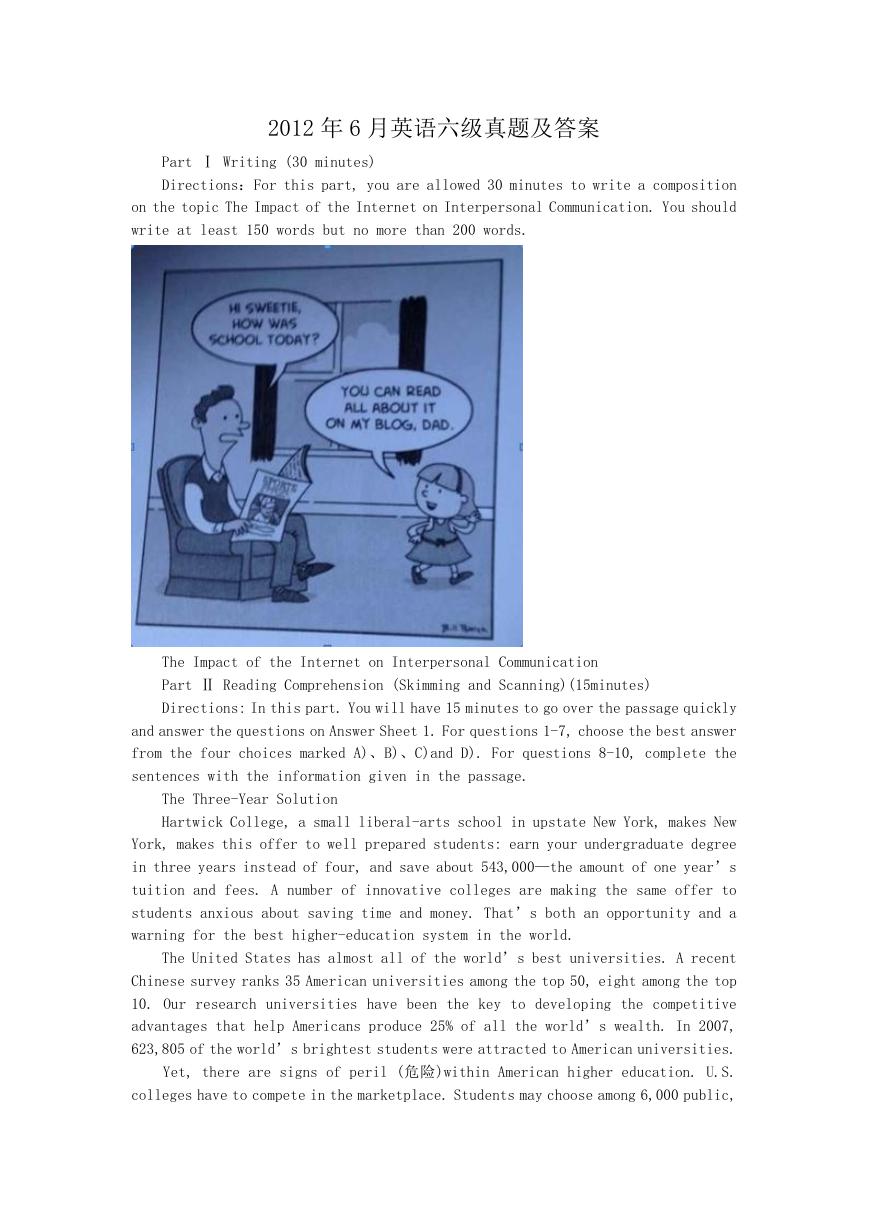
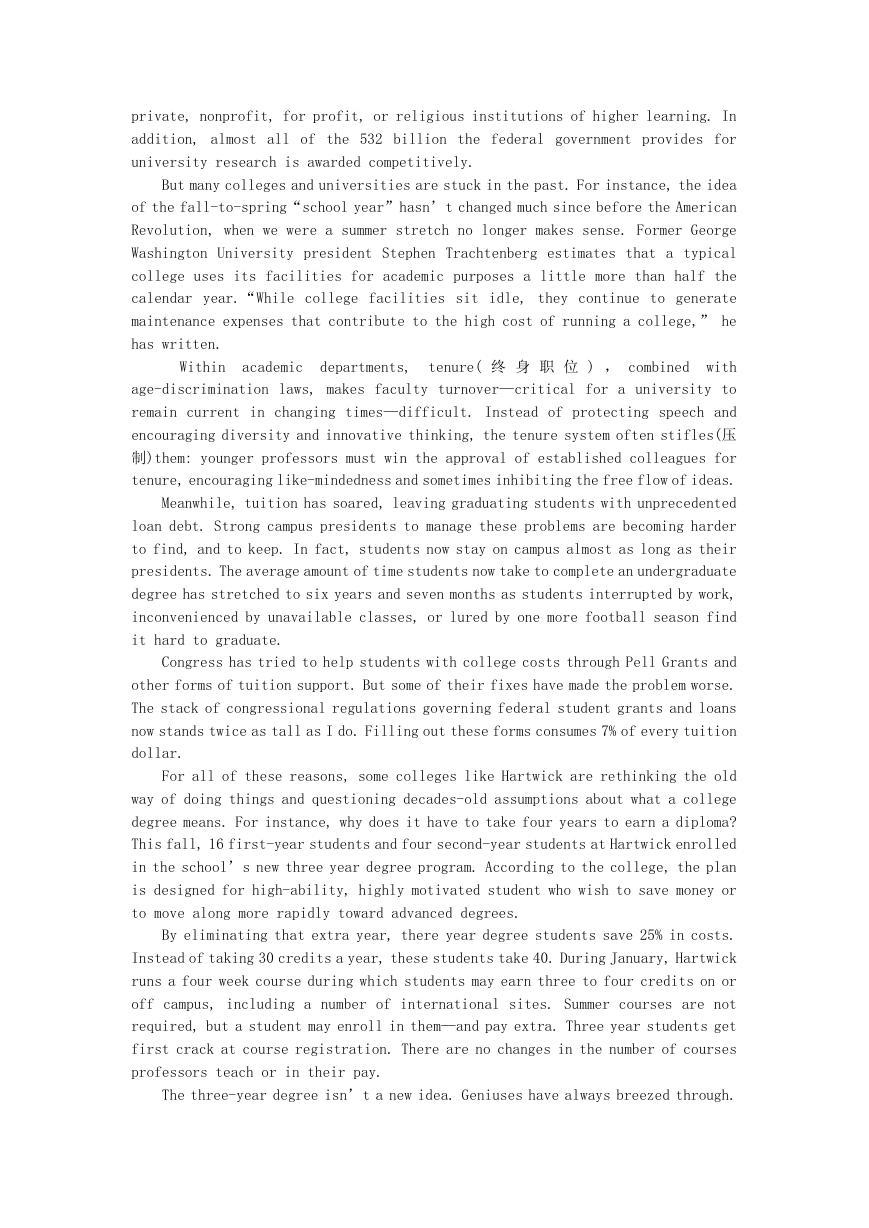
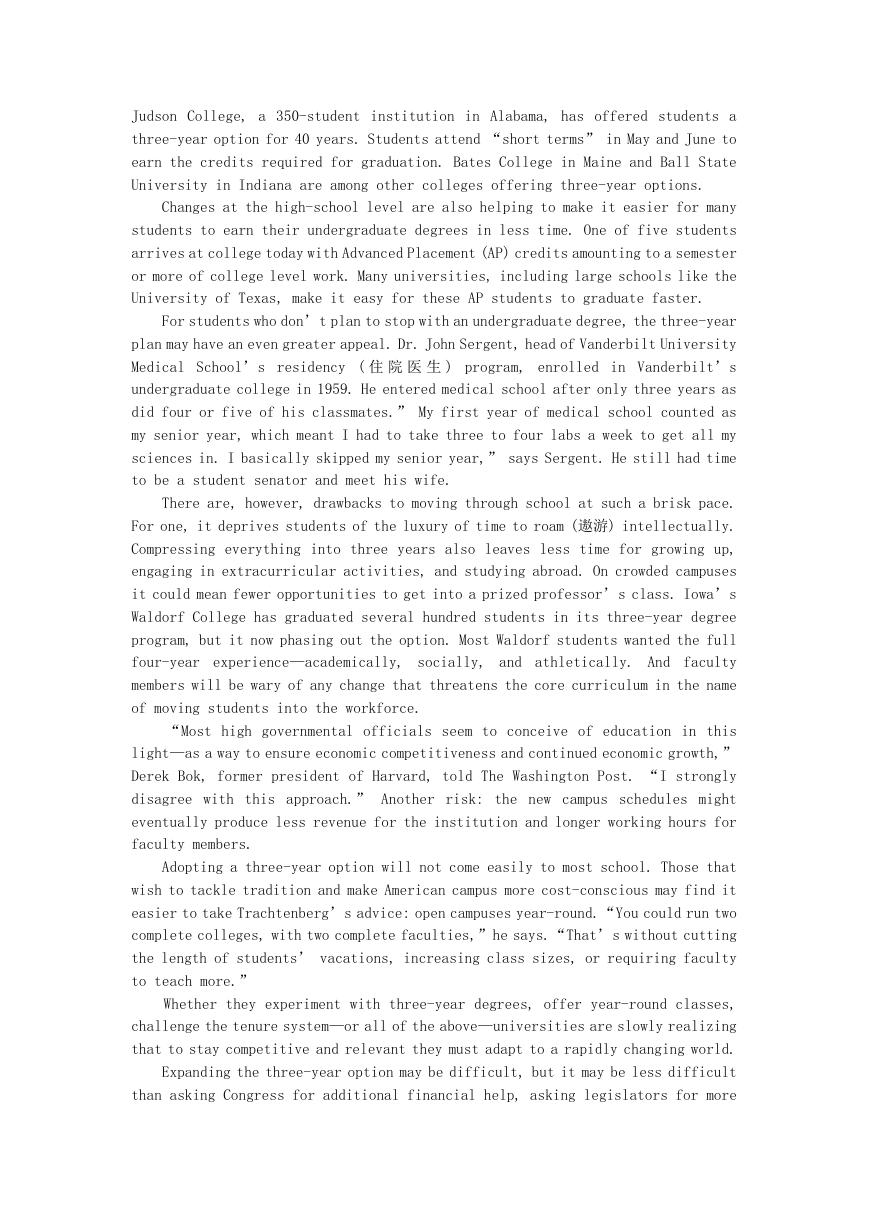

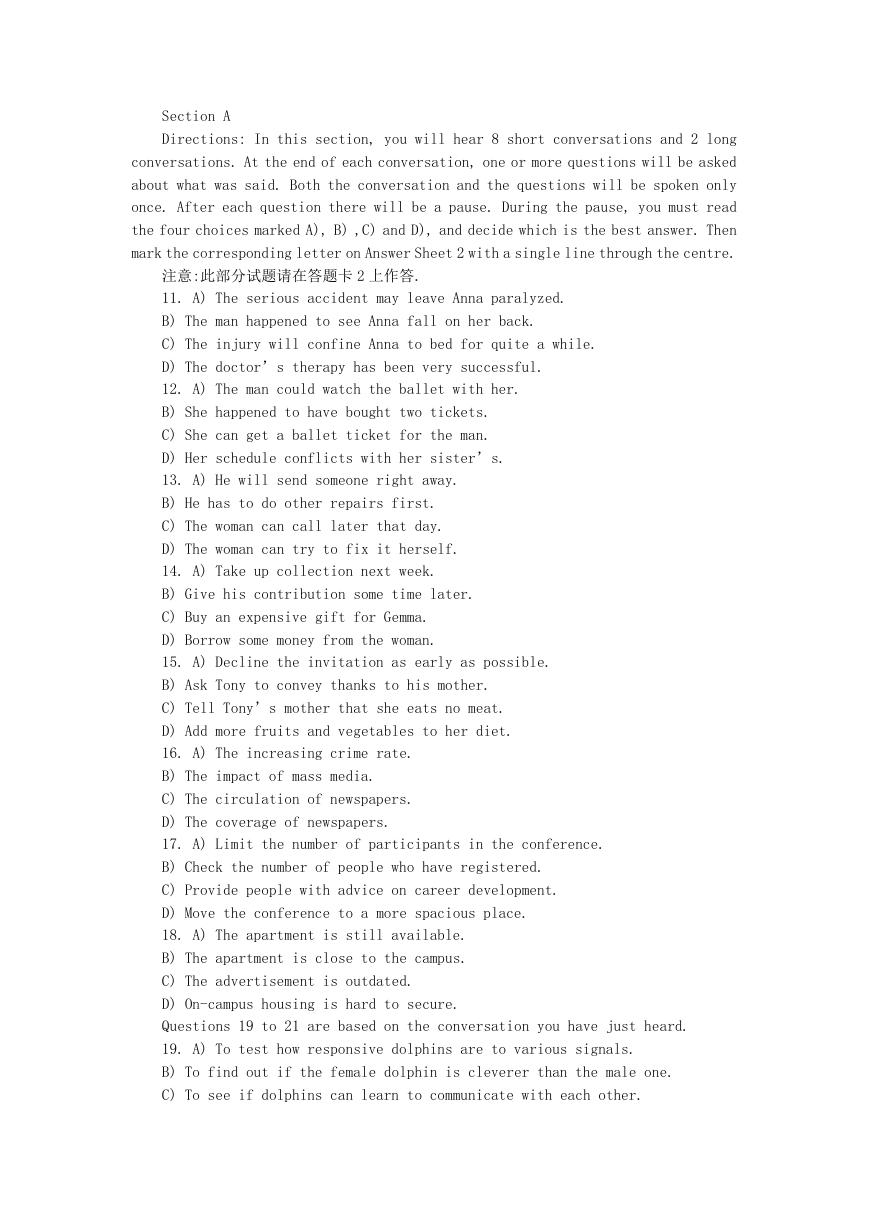


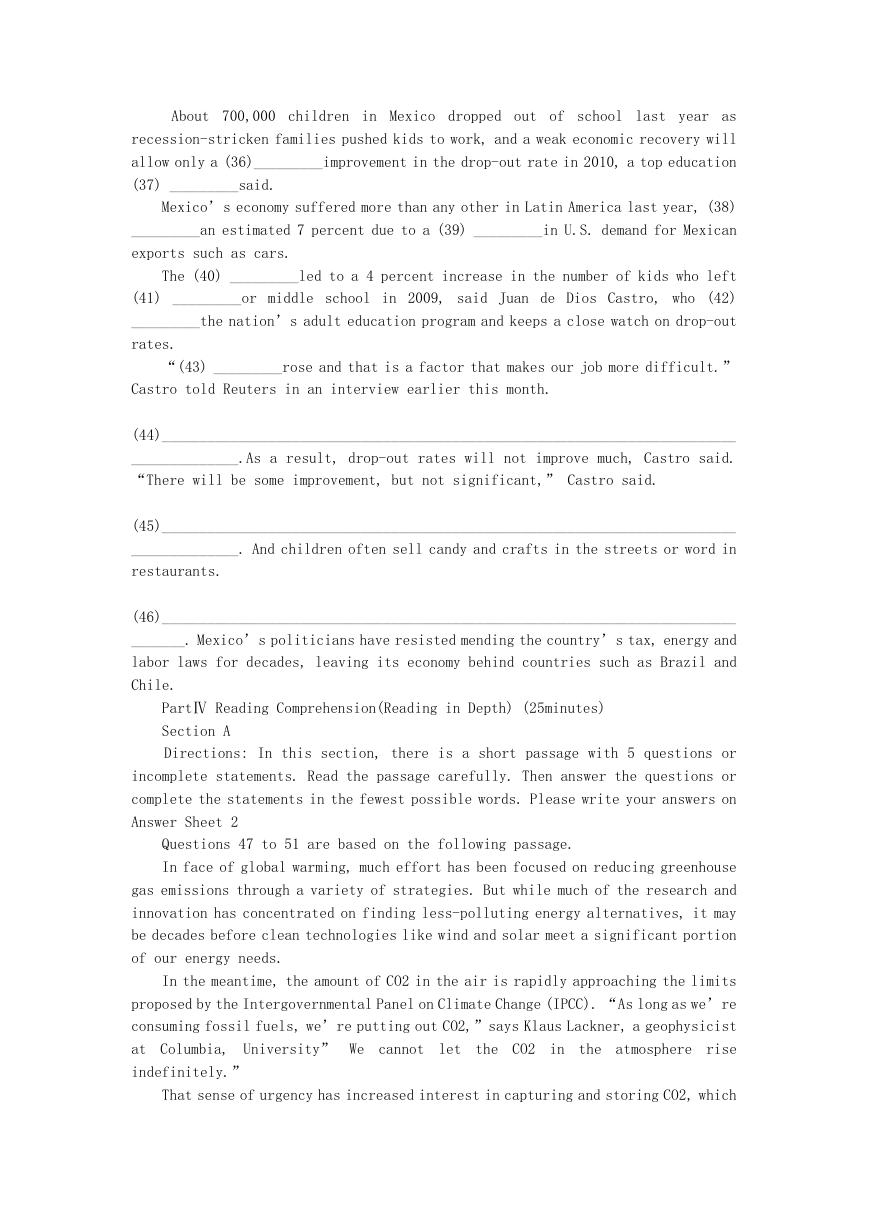








 2023年江西萍乡中考道德与法治真题及答案.doc
2023年江西萍乡中考道德与法治真题及答案.doc 2012年重庆南川中考生物真题及答案.doc
2012年重庆南川中考生物真题及答案.doc 2013年江西师范大学地理学综合及文艺理论基础考研真题.doc
2013年江西师范大学地理学综合及文艺理论基础考研真题.doc 2020年四川甘孜小升初语文真题及答案I卷.doc
2020年四川甘孜小升初语文真题及答案I卷.doc 2020年注册岩土工程师专业基础考试真题及答案.doc
2020年注册岩土工程师专业基础考试真题及答案.doc 2023-2024学年福建省厦门市九年级上学期数学月考试题及答案.doc
2023-2024学年福建省厦门市九年级上学期数学月考试题及答案.doc 2021-2022学年辽宁省沈阳市大东区九年级上学期语文期末试题及答案.doc
2021-2022学年辽宁省沈阳市大东区九年级上学期语文期末试题及答案.doc 2022-2023学年北京东城区初三第一学期物理期末试卷及答案.doc
2022-2023学年北京东城区初三第一学期物理期末试卷及答案.doc 2018上半年江西教师资格初中地理学科知识与教学能力真题及答案.doc
2018上半年江西教师资格初中地理学科知识与教学能力真题及答案.doc 2012年河北国家公务员申论考试真题及答案-省级.doc
2012年河北国家公务员申论考试真题及答案-省级.doc 2020-2021学年江苏省扬州市江都区邵樊片九年级上学期数学第一次质量检测试题及答案.doc
2020-2021学年江苏省扬州市江都区邵樊片九年级上学期数学第一次质量检测试题及答案.doc 2022下半年黑龙江教师资格证中学综合素质真题及答案.doc
2022下半年黑龙江教师资格证中学综合素质真题及答案.doc